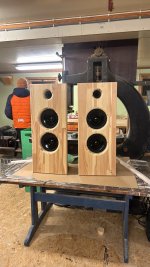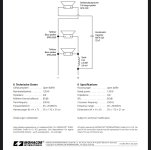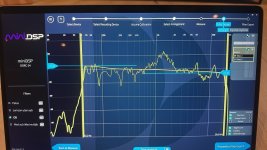Last edited by a moderator:
Maybe you mount the fullrange drives too deep? Did you test it with the fullrange drives in front ?
Last edited by a moderator:
It can be that formed waveguid, increasing SPL in that region and also because smaller baffle first dipole peak was also moving to same frequencies.
Make measurements form other angles until 90 degrees, this can probably help to determine actual reason.
Make measurements form other angles until 90 degrees, this can probably help to determine actual reason.
It looks like you modified (mostly eliminated) the wings that brace the rear also. Those would have made variable path lengths for the woofers which likely smoothed midrange response. It is easy to mock those up and temporarily mount them to see if it helps your measured problem (assuming the measured frequency response is correct). This can be done with thin wood, cardboard, Fome-Cor, whatever taped to the baflfe.
Your overall height looks quite a bit shorter also. If you are measuring with a long time window and are capturing floor bounce, that could be part of the problem in the measurement also. Moving the speaker or microphone up and down and watching to see if the peak changes frequency can help determine if this is an issue in the measurement.
How are you measuring? Distance from microphone to speaker? Distance to reflective stuff in environment? Windowing/gating?
Baffle width as built? Baffle width of original design?
Does the speaker sound like it measures or are you more worried about the measured response as a separate thing?
Your overall height looks quite a bit shorter also. If you are measuring with a long time window and are capturing floor bounce, that could be part of the problem in the measurement also. Moving the speaker or microphone up and down and watching to see if the peak changes frequency can help determine if this is an issue in the measurement.
How are you measuring? Distance from microphone to speaker? Distance to reflective stuff in environment? Windowing/gating?
Baffle width as built? Baffle width of original design?
Does the speaker sound like it measures or are you more worried about the measured response as a separate thing?
Last edited:
You mounted the midrange (the small driver at top) deep inside a hole. Every cavity like this resonates, and this is probably what is causing the two sharp peaks at 5.5k and 11k Hz. It would be better if the driver has free space around it both in front and to the rear. This is much less of a problem for the larger drivers because the cavity is much less deep than it is wide, so the resonance is not well developed (has a very low Q). To fix this, you will need to modify the baffle itself.
The large peak just above 1kHz is probably the dipole peak. You will need to add compensation in the crossover. If you will be using a miniDSP this is easy with a PEQ band.
I would start by modifying the baffle. If you could front mount the driver and open up the rear around the magnet that would be a step in the right direction. You could first do a test by cutting out the same overall baffle size but from a thin material (like 1/4" thick plywood or OSB) and then make the same hole for the tweeter. Front mount (not rear mount) the driver, remeasure it, and compare it to the current deeper one. If that looks good you can try to modify your current baffle to match.
The large peak just above 1kHz is probably the dipole peak. You will need to add compensation in the crossover. If you will be using a miniDSP this is easy with a PEQ band.
I would start by modifying the baffle. If you could front mount the driver and open up the rear around the magnet that would be a step in the right direction. You could first do a test by cutting out the same overall baffle size but from a thin material (like 1/4" thick plywood or OSB) and then make the same hole for the tweeter. Front mount (not rear mount) the driver, remeasure it, and compare it to the current deeper one. If that looks good you can try to modify your current baffle to match.
Yes thats a easy fix, ill try to do some testing on the bracings.It looks like you modified (mostly eliminated) the wings that brace the rear also. Those would have made variable path lengths for the woofers which likely smoothed midrange response. It is easy to mock those up and temporarily mount them to see if it helps your measured problem (assuming the measured frequency response is correct). This can be done with thin wood, cardboard, Fome-Cor, whatever taped to the baflfe.
Its easier to make the them bigger than smaller 🙂
The total length is about 27 cm shorter than the original design. now i have moved the fullrange driver out almost to the baffle surface, and have been testing them on top of my kitchen table, everything sounds much better now.Your overall height looks quite a bit shorter also. If you are measuring with a long time window and are capturing floor bounce, that could be part of the problem in the measurement also. Moving the speaker or microphone up and down and watching to see if the peak changes frequency can help determine if this is an issue in the measurement.
How are you measuring? Distance from microphone to speaker? Distance to reflective stuff in environment? Windowing/gating?
im measuring from the listening position. about 2meters to both speakers.
the reason i made them shorter was to not having the stick up above my windows in the livingroom. so yes i have windows behind (but above the top of the speaker)
i can test them in the same place on a small stand or on a carpet maybe?
My baffle: 340x830mm 40mmBaffle width as built? Baffle width of original design?
Orginal: 350x1100mm 21mm
Yes i sounded like measured, now after i moved the 3" driver it sounded much better.Does the speaker sound like it measures or are you more worried about the measured response as a separate thing?
the goal is to make the sound as balanced as possible before room correction.
Are you measuring both speakers simultaneously? If so, and you are using a correlated noise source, it will be very difficult to get accurate measurements at higher frequencies, since the two speakers will constructively and destructively interfere unless everything is positioned perfectly.2meters to both speakers.
2 meters is good. You need to be at a decent distance from larger speakers and those with low slope crossovers for proper driver integration. Dipoles also.2meters to both speakers
i made them shorter
The width difference on its own seems trivial. Rear braces may be a bigger issue, assuming there's an issue related to width/front-rear path length.My baffle: 340x830mm 40mm
Orginal: 350x1100mm 21mm
I've seen a 10 inch driver height difference make a pretty big impact to lower midrange frequency response at the listening position, so that seems potentially more interesting. Your measurement height changed significantly between tests along with the other modifications, so hard to say what's what. Ultimately the effect of the floor reflection can likely be mitigated with equalization (just don't try to fill in a super deep hole with EQ if there is one). Sometimes aesthetics have to take precedence, so at least you have a tool to offset some of the compromises.
A lot of my questioning was related to what is a measurement artifact and what's real. It's hard to figure out where someone is in their experience and test setup from a distance, so sorry if any of this is obvious to you.
Maybe you mount the fullrange drives too deep? Did you test it with the fullrange drives in front ?
That would be my first guess.
dave
It was nice to hear that it got better by moving the midrange 👍.
I am also considering this build kit. Did you buy the drivers separately? What kind of dsp are you using?
I am also considering this build kit. Did you buy the drivers separately? What kind of dsp are you using?
- Home
- Loudspeakers
- Multi-Way
- Open baffle problem (based on Monacor Katana)


